Financial Analysis Report: Prospective Analysis and Valuation
VerifiedAdded on 2020/04/07
|6
|1003
|44
Report
AI Summary
This financial analysis report evaluates a company's performance based on various financial data and ratios. The analysis includes a prospective analysis, examining factors like sales growth, NOPAT margin, and debt ratio. It also assesses the company's overall performance, highlighting its ability to generate profit and efficiently utilize fixed assets, while also pointing out areas needing improvement, such as paying off short-term obligations and considering dividend payments. Furthermore, the report conducts a valuation analysis using the abnormal earnings method, concluding that the company is positioned to sell its equity at a premium due to positive abnormal earnings. The report references key financial concepts and includes relevant sources.

Running head: FINANCIAL ANALYSIS
Financial analysis
Name of the student
Name of the university
Author note
Financial analysis
Name of the student
Name of the university
Author note
Paraphrase This Document
Need a fresh take? Get an instant paraphrase of this document with our AI Paraphraser
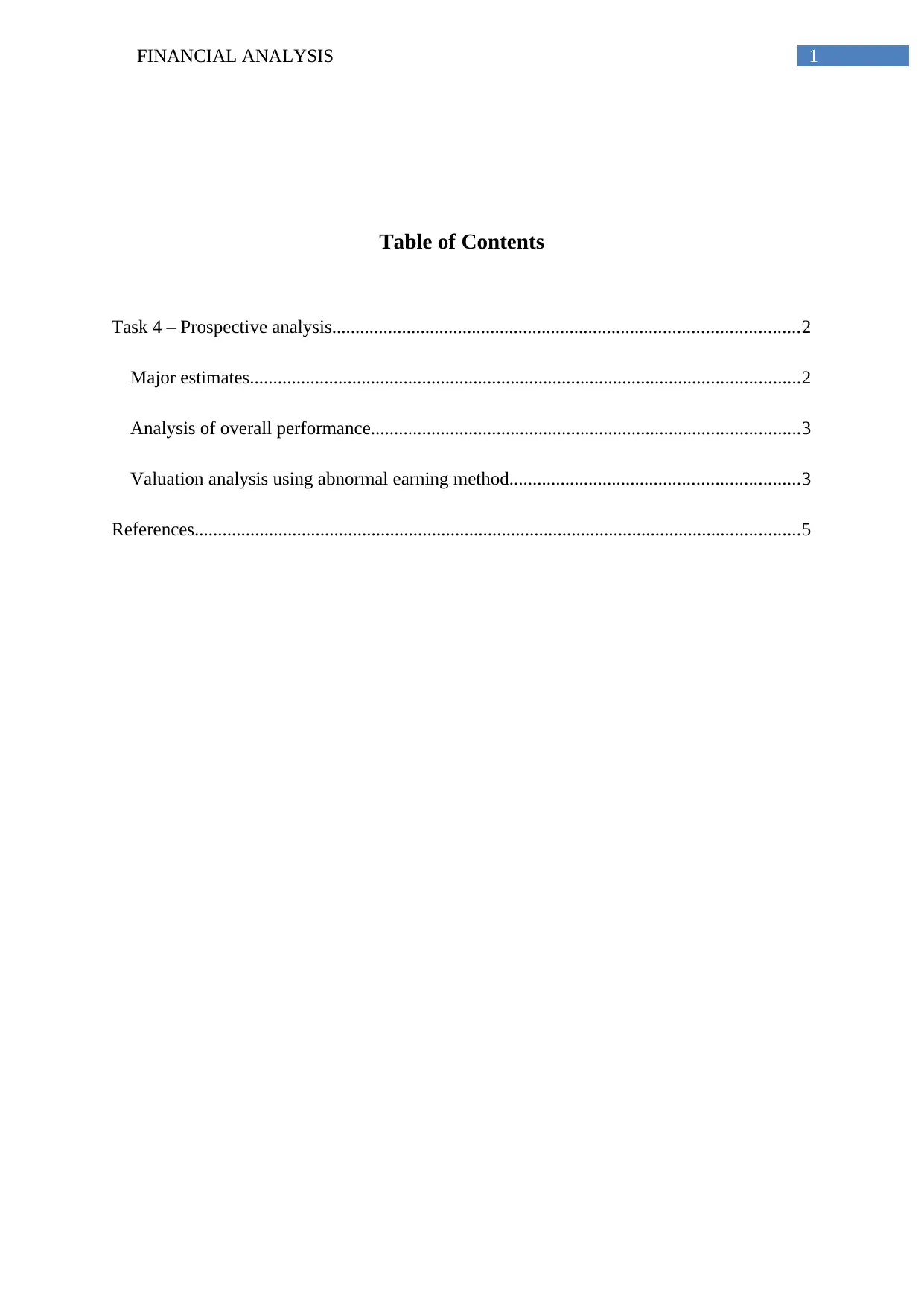
1FINANCIAL ANALYSIS
Table of Contents
Task 4 – Prospective analysis....................................................................................................2
Major estimates......................................................................................................................2
Analysis of overall performance............................................................................................3
Valuation analysis using abnormal earning method..............................................................3
References..................................................................................................................................5
Table of Contents
Task 4 – Prospective analysis....................................................................................................2
Major estimates......................................................................................................................2
Analysis of overall performance............................................................................................3
Valuation analysis using abnormal earning method..............................................................3
References..................................................................................................................................5
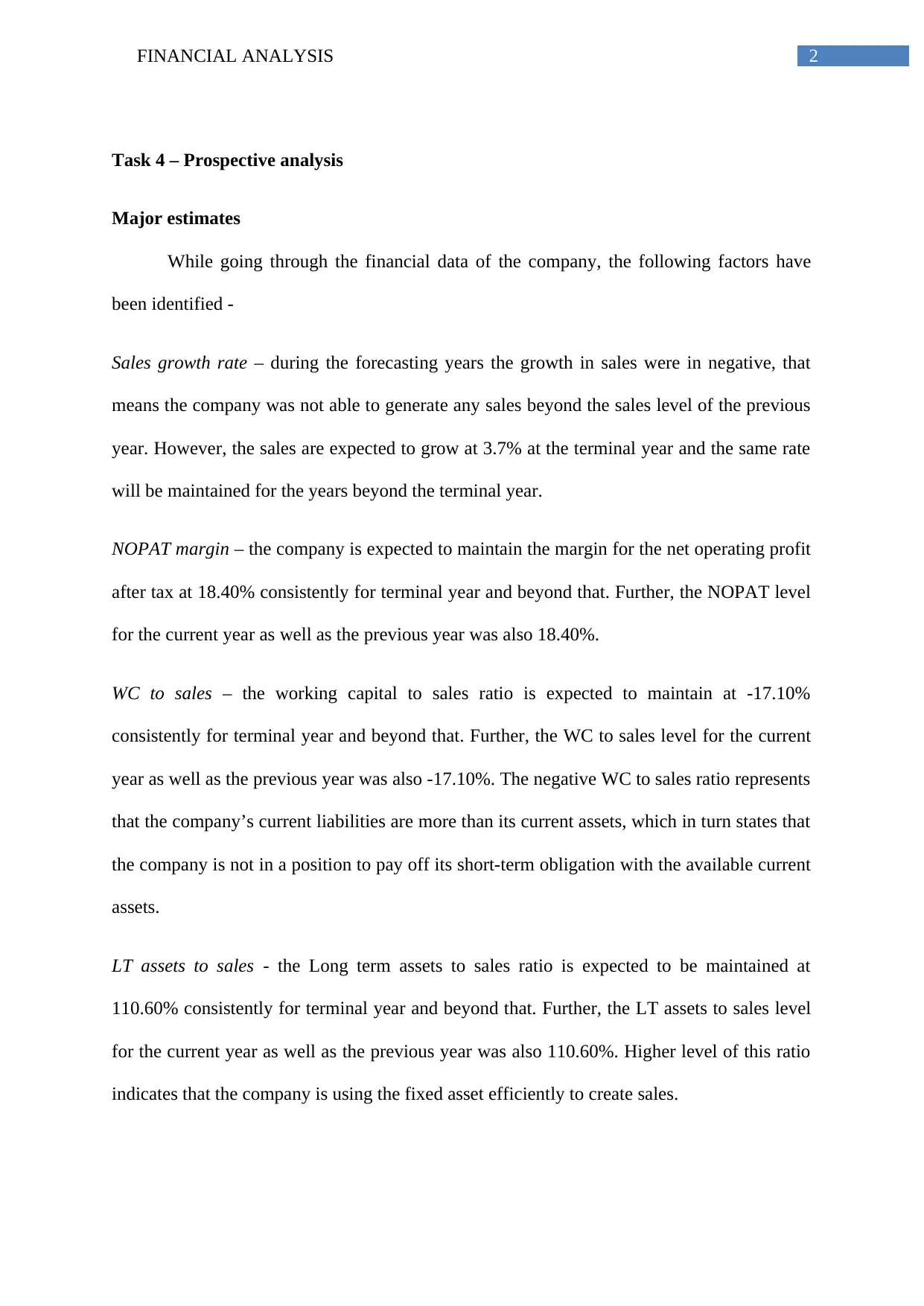
2FINANCIAL ANALYSIS
Task 4 – Prospective analysis
Major estimates
While going through the financial data of the company, the following factors have
been identified -
Sales growth rate – during the forecasting years the growth in sales were in negative, that
means the company was not able to generate any sales beyond the sales level of the previous
year. However, the sales are expected to grow at 3.7% at the terminal year and the same rate
will be maintained for the years beyond the terminal year.
NOPAT margin – the company is expected to maintain the margin for the net operating profit
after tax at 18.40% consistently for terminal year and beyond that. Further, the NOPAT level
for the current year as well as the previous year was also 18.40%.
WC to sales – the working capital to sales ratio is expected to maintain at -17.10%
consistently for terminal year and beyond that. Further, the WC to sales level for the current
year as well as the previous year was also -17.10%. The negative WC to sales ratio represents
that the company’s current liabilities are more than its current assets, which in turn states that
the company is not in a position to pay off its short-term obligation with the available current
assets.
LT assets to sales - the Long term assets to sales ratio is expected to be maintained at
110.60% consistently for terminal year and beyond that. Further, the LT assets to sales level
for the current year as well as the previous year was also 110.60%. Higher level of this ratio
indicates that the company is using the fixed asset efficiently to create sales.
Task 4 – Prospective analysis
Major estimates
While going through the financial data of the company, the following factors have
been identified -
Sales growth rate – during the forecasting years the growth in sales were in negative, that
means the company was not able to generate any sales beyond the sales level of the previous
year. However, the sales are expected to grow at 3.7% at the terminal year and the same rate
will be maintained for the years beyond the terminal year.
NOPAT margin – the company is expected to maintain the margin for the net operating profit
after tax at 18.40% consistently for terminal year and beyond that. Further, the NOPAT level
for the current year as well as the previous year was also 18.40%.
WC to sales – the working capital to sales ratio is expected to maintain at -17.10%
consistently for terminal year and beyond that. Further, the WC to sales level for the current
year as well as the previous year was also -17.10%. The negative WC to sales ratio represents
that the company’s current liabilities are more than its current assets, which in turn states that
the company is not in a position to pay off its short-term obligation with the available current
assets.
LT assets to sales - the Long term assets to sales ratio is expected to be maintained at
110.60% consistently for terminal year and beyond that. Further, the LT assets to sales level
for the current year as well as the previous year was also 110.60%. Higher level of this ratio
indicates that the company is using the fixed asset efficiently to create sales.
⊘ This is a preview!⊘
Do you want full access?
Subscribe today to unlock all pages.

Trusted by 1+ million students worldwide
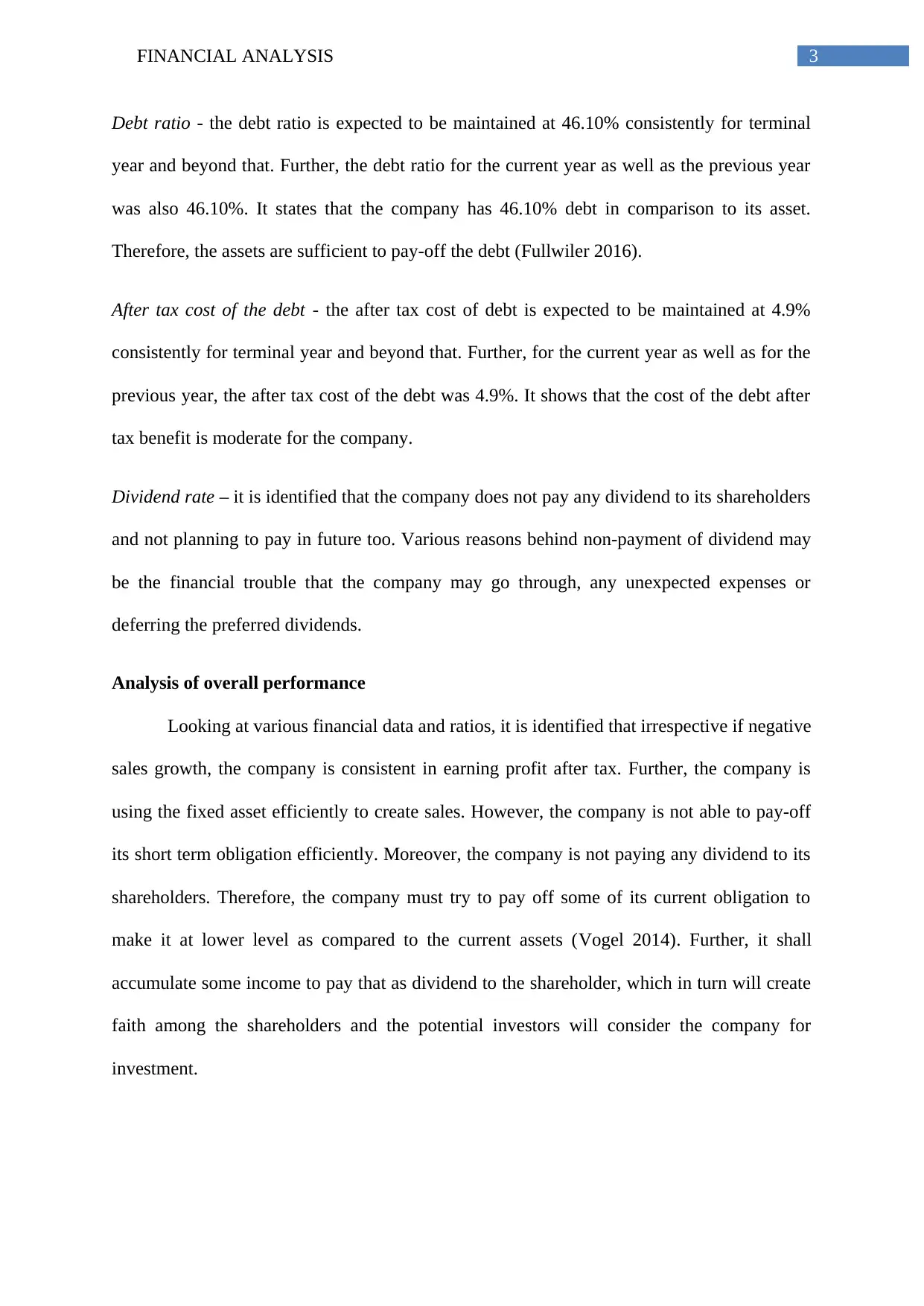
3FINANCIAL ANALYSIS
Debt ratio - the debt ratio is expected to be maintained at 46.10% consistently for terminal
year and beyond that. Further, the debt ratio for the current year as well as the previous year
was also 46.10%. It states that the company has 46.10% debt in comparison to its asset.
Therefore, the assets are sufficient to pay-off the debt (Fullwiler 2016).
After tax cost of the debt - the after tax cost of debt is expected to be maintained at 4.9%
consistently for terminal year and beyond that. Further, for the current year as well as for the
previous year, the after tax cost of the debt was 4.9%. It shows that the cost of the debt after
tax benefit is moderate for the company.
Dividend rate – it is identified that the company does not pay any dividend to its shareholders
and not planning to pay in future too. Various reasons behind non-payment of dividend may
be the financial trouble that the company may go through, any unexpected expenses or
deferring the preferred dividends.
Analysis of overall performance
Looking at various financial data and ratios, it is identified that irrespective if negative
sales growth, the company is consistent in earning profit after tax. Further, the company is
using the fixed asset efficiently to create sales. However, the company is not able to pay-off
its short term obligation efficiently. Moreover, the company is not paying any dividend to its
shareholders. Therefore, the company must try to pay off some of its current obligation to
make it at lower level as compared to the current assets (Vogel 2014). Further, it shall
accumulate some income to pay that as dividend to the shareholder, which in turn will create
faith among the shareholders and the potential investors will consider the company for
investment.
Debt ratio - the debt ratio is expected to be maintained at 46.10% consistently for terminal
year and beyond that. Further, the debt ratio for the current year as well as the previous year
was also 46.10%. It states that the company has 46.10% debt in comparison to its asset.
Therefore, the assets are sufficient to pay-off the debt (Fullwiler 2016).
After tax cost of the debt - the after tax cost of debt is expected to be maintained at 4.9%
consistently for terminal year and beyond that. Further, for the current year as well as for the
previous year, the after tax cost of the debt was 4.9%. It shows that the cost of the debt after
tax benefit is moderate for the company.
Dividend rate – it is identified that the company does not pay any dividend to its shareholders
and not planning to pay in future too. Various reasons behind non-payment of dividend may
be the financial trouble that the company may go through, any unexpected expenses or
deferring the preferred dividends.
Analysis of overall performance
Looking at various financial data and ratios, it is identified that irrespective if negative
sales growth, the company is consistent in earning profit after tax. Further, the company is
using the fixed asset efficiently to create sales. However, the company is not able to pay-off
its short term obligation efficiently. Moreover, the company is not paying any dividend to its
shareholders. Therefore, the company must try to pay off some of its current obligation to
make it at lower level as compared to the current assets (Vogel 2014). Further, it shall
accumulate some income to pay that as dividend to the shareholder, which in turn will create
faith among the shareholders and the potential investors will consider the company for
investment.
Paraphrase This Document
Need a fresh take? Get an instant paraphrase of this document with our AI Paraphraser
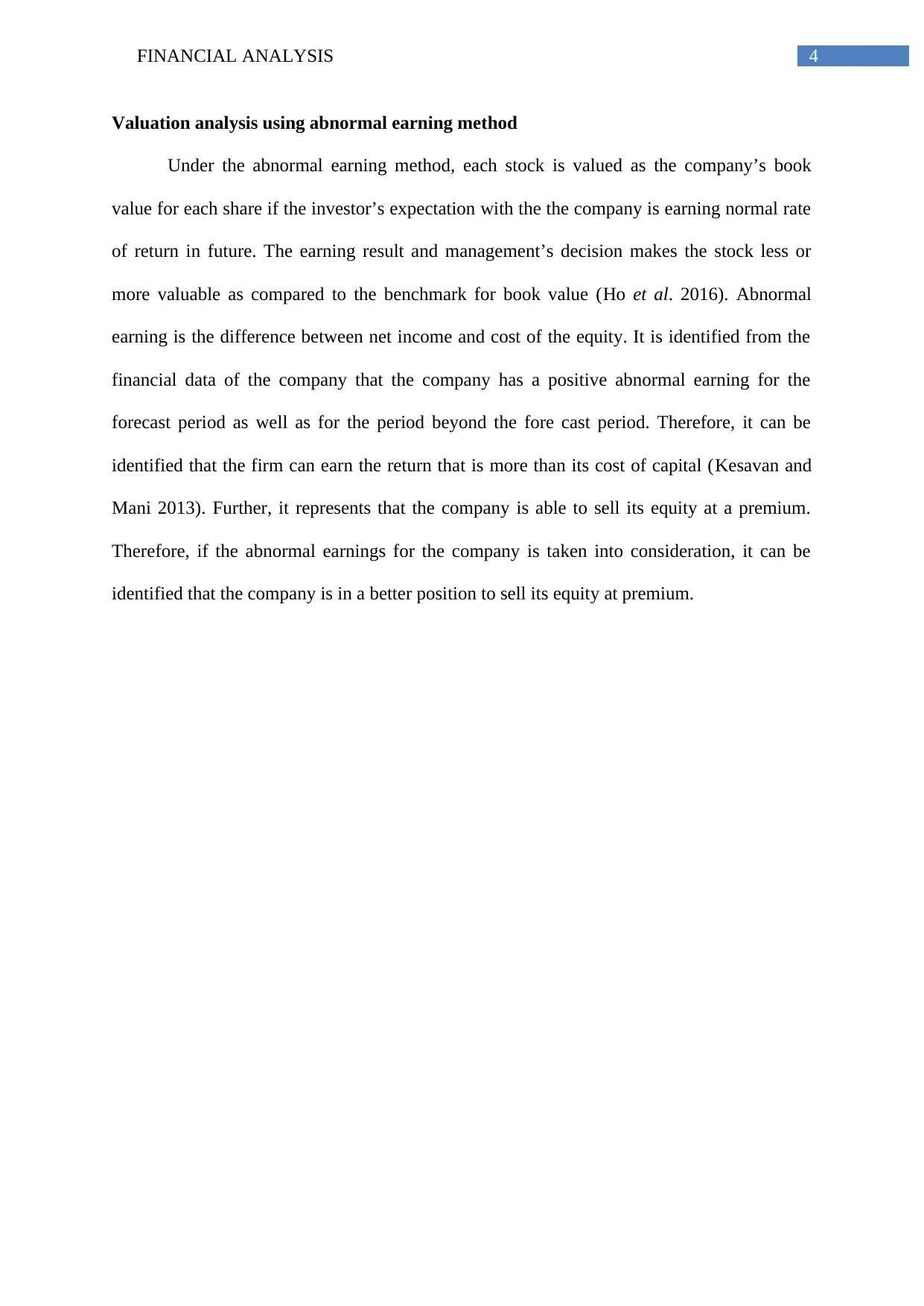
4FINANCIAL ANALYSIS
Valuation analysis using abnormal earning method
Under the abnormal earning method, each stock is valued as the company’s book
value for each share if the investor’s expectation with the the company is earning normal rate
of return in future. The earning result and management’s decision makes the stock less or
more valuable as compared to the benchmark for book value (Ho et al. 2016). Abnormal
earning is the difference between net income and cost of the equity. It is identified from the
financial data of the company that the company has a positive abnormal earning for the
forecast period as well as for the period beyond the fore cast period. Therefore, it can be
identified that the firm can earn the return that is more than its cost of capital (Kesavan and
Mani 2013). Further, it represents that the company is able to sell its equity at a premium.
Therefore, if the abnormal earnings for the company is taken into consideration, it can be
identified that the company is in a better position to sell its equity at premium.
Valuation analysis using abnormal earning method
Under the abnormal earning method, each stock is valued as the company’s book
value for each share if the investor’s expectation with the the company is earning normal rate
of return in future. The earning result and management’s decision makes the stock less or
more valuable as compared to the benchmark for book value (Ho et al. 2016). Abnormal
earning is the difference between net income and cost of the equity. It is identified from the
financial data of the company that the company has a positive abnormal earning for the
forecast period as well as for the period beyond the fore cast period. Therefore, it can be
identified that the firm can earn the return that is more than its cost of capital (Kesavan and
Mani 2013). Further, it represents that the company is able to sell its equity at a premium.
Therefore, if the abnormal earnings for the company is taken into consideration, it can be
identified that the company is in a better position to sell its equity at premium.
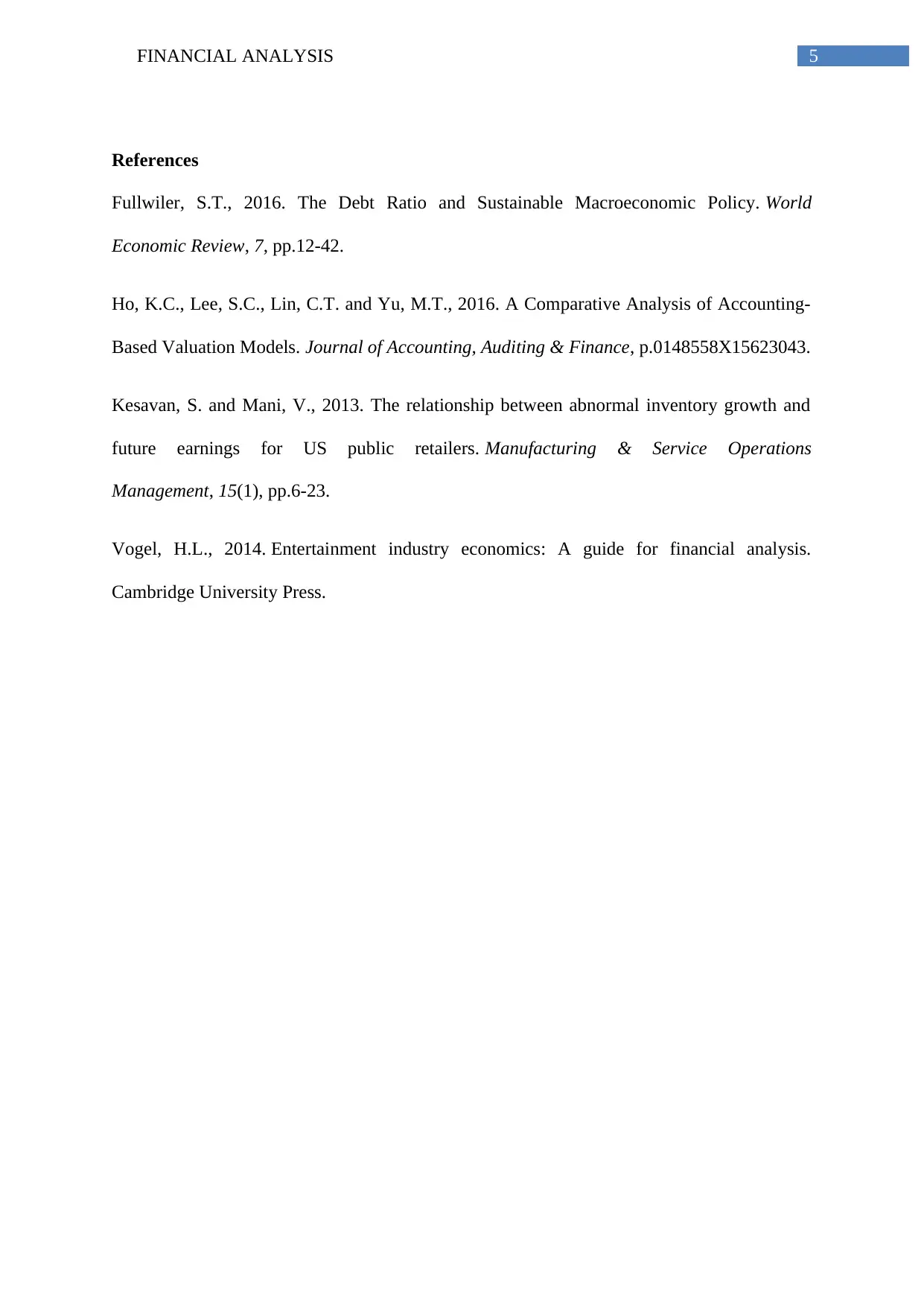
5FINANCIAL ANALYSIS
References
Fullwiler, S.T., 2016. The Debt Ratio and Sustainable Macroeconomic Policy. World
Economic Review, 7, pp.12-42.
Ho, K.C., Lee, S.C., Lin, C.T. and Yu, M.T., 2016. A Comparative Analysis of Accounting-
Based Valuation Models. Journal of Accounting, Auditing & Finance, p.0148558X15623043.
Kesavan, S. and Mani, V., 2013. The relationship between abnormal inventory growth and
future earnings for US public retailers. Manufacturing & Service Operations
Management, 15(1), pp.6-23.
Vogel, H.L., 2014. Entertainment industry economics: A guide for financial analysis.
Cambridge University Press.
References
Fullwiler, S.T., 2016. The Debt Ratio and Sustainable Macroeconomic Policy. World
Economic Review, 7, pp.12-42.
Ho, K.C., Lee, S.C., Lin, C.T. and Yu, M.T., 2016. A Comparative Analysis of Accounting-
Based Valuation Models. Journal of Accounting, Auditing & Finance, p.0148558X15623043.
Kesavan, S. and Mani, V., 2013. The relationship between abnormal inventory growth and
future earnings for US public retailers. Manufacturing & Service Operations
Management, 15(1), pp.6-23.
Vogel, H.L., 2014. Entertainment industry economics: A guide for financial analysis.
Cambridge University Press.
⊘ This is a preview!⊘
Do you want full access?
Subscribe today to unlock all pages.

Trusted by 1+ million students worldwide
1 out of 6
Related Documents
Your All-in-One AI-Powered Toolkit for Academic Success.
+13062052269
info@desklib.com
Available 24*7 on WhatsApp / Email
![[object Object]](/_next/static/media/star-bottom.7253800d.svg)
Unlock your academic potential
Copyright © 2020–2025 A2Z Services. All Rights Reserved. Developed and managed by ZUCOL.





